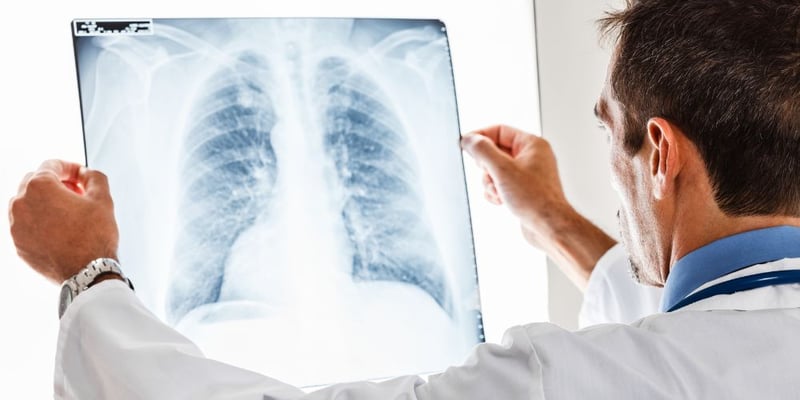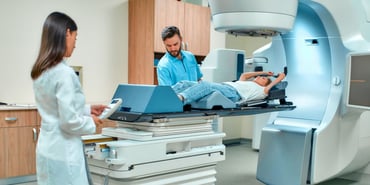
Hearing your doctor say that you have a lung nodule usually leads to a lot of questions. What does that mean? Is it cancer? Will more develop?
First, it’s helpful to keep in mind that most of these growths are benign (non-cancerous). In many cases, treatment is never necessary. Understanding more about lung nodules can help ease your mind. Here’s what you need to know if a lung nodule is detected on your CT scan or chest x-ray.
Lung Nodules: What They Are and Their Causes
A lung (pulmonary) nodule is an abnormal clump of cells that develops in the lung. These cells frequently form after a lung infection. They are fairly common — detected in up to half of adults who have a chest scan for another health concern. In most cases, lung nodules are not lung cancer.
After a while, these cells can calcify (harden), which makes them easier to see on chest imaging tests. Nodules are sometimes referred to as a “shadow” because they appear as a white spot on an x-ray. The number, as well as the size of the nodules, vary among patients. There may be one nodule or many, and they can be big or small. Nodules vary in size, ranging from 3mm to 25mm or more in diameter, with lung nodules less than 9mm considered small.
If the nodule is more than about a half inch in size, there may be some additional tests, including a bronchoscopy, so they can see the nodule and take some samples for biopsy. This can also be done with a CT-scan-guided biopsy.
Previous infections are not the only cause of lung nodules. Long-term exposure to air irritants and autoimmune diseases, such as sarcoidosis and rheumatoid arthritis, can also cause lung nodules to form. In some cases, a pulmonary nodule is a sign of lung cancer. That’s why the biopsy testing of the nodule may be recommended.
Lung Cancer Screening Detects Nodules in High-Risk Patients
The risk for lung nodules is higher in individuals who smoke. This is because tobacco smoke is a known lung irritant. Getting screened for lung cancer is an effective way to detect lung nodules. There is some risk involved because the screening test is a low-dose CT scan of the chest that would be repeated from year to year.
For that reason, not everyone qualifies for lung cancer screening to be covered by insurance. You must meet all three of the following criteria for a lung screening test to be part of the preventive care benefits:
- You must be between the ages of 50 and 80 years old, AND
- You have a “20-pack-year” smoking history, AND
- You currently smoke or have quit within the last 15 years.
A “pack-year” is smoking one pack of cigarettes per day for a year, according to the CDC. This means that ten pack years could be from smoking a pack a day for 10 years or smoking two packs a day for five years. To help reduce your risk of both lung nodules and lung cancer, consider kicking the habit.
Related reading: 6 Tips to Quit Smoking and Reduce Lung Cancer Risk
The scans will be reviewed by your physician to determine if there are any areas of concern that need to be monitored or biopsied for lung cancer.
Read our blog about lung cancer screening to learn who should be screened for lung cancer.
How to Know If the Nodule is Cancerous
There are several different courses of action your healthcare team can take if a pulmonary nodule is detected in your lungs. Although the majority (about 95%) of lung nodules are harmless, your physician will want to follow through to determine whether your nodule is cancerous. Your doctor is likely to do the following:
- Assess your personal risk for lung cancer. There are several risk factors — a family history of lung cancer, being older than 50 years old, smoking, and having a larger nodule — that contribute to an increased chance of developing a lung nodule that is cancerous.
- Evaluate images and order more if necessary. Active surveillance (watching over time) might be an option in cases where the size of the nodule is small. Larger nodules will likely require additional tests, such as another CT or PET scan, to determine the cause and rule out lung cancer.
- Perform a biopsy if needed. While other tests can suggest cancer, a biopsy is the only way to confirm it. Nodules 9 mm or larger are usually biopsied. Patients with nodules of this size will likely be scheduled for a biopsy procedure so the physician can retrieve a tissue sample from the nodule.
After the nodule is biopsied, a lab pathologist will check it for cancer, infection, scar tissue, and other lung problems. Results that show cancer mean further testing will be needed to determine what type of cancer it is.
When Monitoring a Lung Nodule Isn’t Enough
Oftentimes, lung nodules that are small and noncancerous can be safely monitored rather than being treated. This tends to be true in cases where the nodules aren’t interfering with breathing. Still, there are times when symptoms arise that need more attention. Be sure to contact your physician if things change during the time your nodule is being monitored.
Keep in mind that symptoms do not automatically mean your nodule is cancerous. Most often, non-cancerous lung nodules do not affect your quality of life nor require treatment. However, it’s best to let your doctor take a closer look.
If the nodule grows, causes symptoms, or is cancerous, surgery may be needed to remove it. If it doesn’t require treatment, your doctor may at least be able to provide something that can help you find relief.
If the Lung Nodule is Cancerous, What’s Next?
If your lung nodule is biopsied and found to be cancer, your healthcare provider will recommend you see an oncologist. Try to stay calm and remember that it’s often successfully treated with surgery and/or radiation and even medical oncology treatments such as targeted therapy and chemotherapy.
Those who find lung cancer at an early stage have a very positive prognosis. This means there is a high likelihood of successful treatment. If you notice any lung cancer symptoms, you should always talk to your doctor, including signs such as:
- Coughing up blood or a change in your cough
- Fever or chills without another infection, such as a cold
- Chest pain
- Shortness of breath
- Unexplained weight loss
Related reading: 7 Surprising Signs and Symptoms of Lung Cancer
Expert Lung Cancer Care in Portland-Vancouver
At Compass Oncology, we are here to help. We offer leading-edge technology and personalized care plans for patients with lung cancer. If you’re newly diagnosed with lung cancer, have a look at what to expect next.
We can also provide you with a second opinion regarding your diagnosis and recommended lung cancer treatment if needed.
To start getting the treatment you need, we encourage you to schedule a consultation with an oncologist specializing in lung cancer care. We have several convenient locations that can be found in the Portland, OR, or Vancouver, WA area. Learn more about the lung cancer specialists at Compass and why you should choose us for your lung cancer care.

